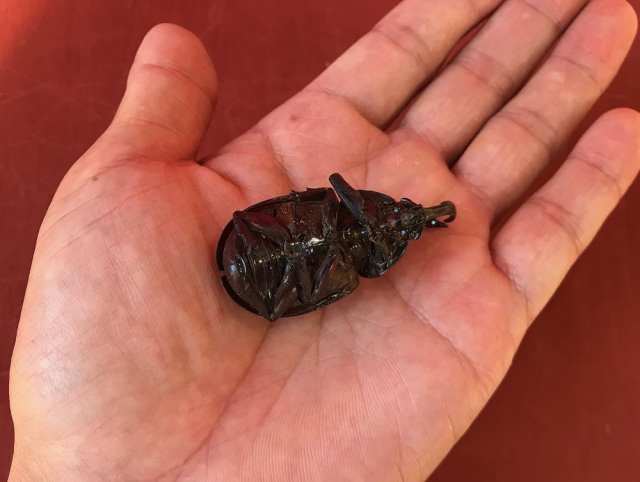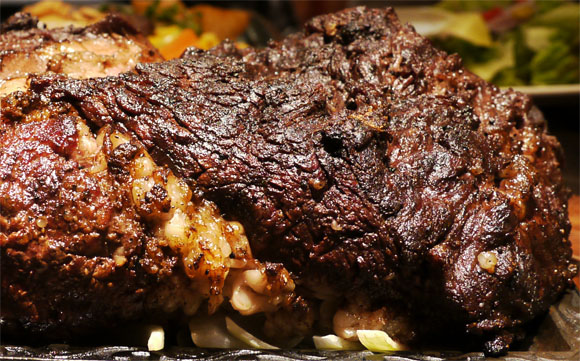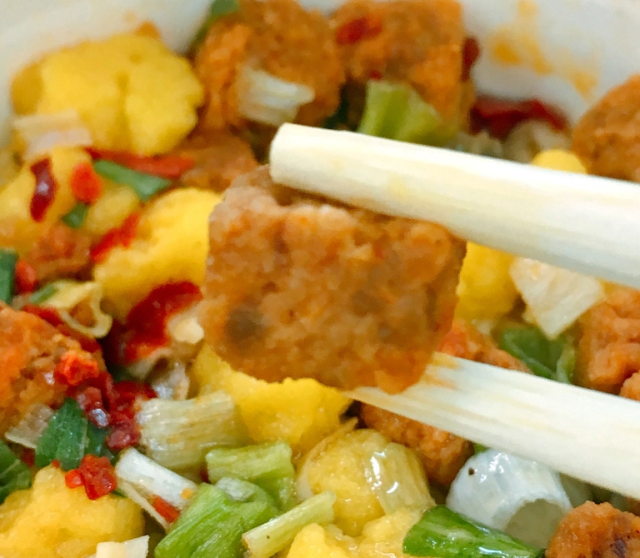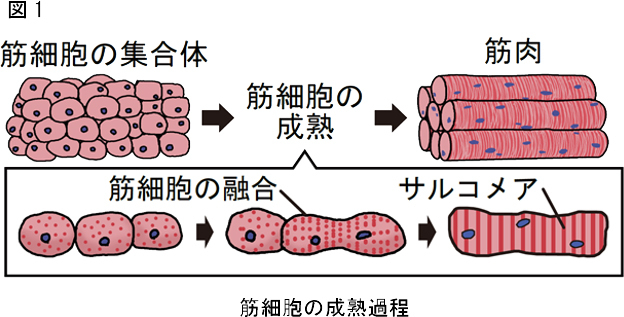
It may not look much like steak, but researchers say it will taste just as good.
Nissin has shown itself to be no stranger to innovation, having developed both a bluetooth fork that detects and drowns out slurping sounds as well as a rig that ensures no cabbage is wasted in instant yakisoba.
And while those inventions are arguably insane, the makers of Cup Noodle are also involved in more conventional R&D, such as the Japan Science and Technology Agency’s (JST) Mirai Project which aims to solve social issues through creative solutions. In this instance, Nissin and the JST are tackling the development of cultured meat.
It’s no surprise that with the growing and developing global population, meat production is nearing a breaking point and cannot be sustained without severe environmental consequences. So all around the world, experts are searching for alternatives such as switching to insect-based foods.
▼ Not the best alternative to a cheeseburger.

Another possibility is cultured meat, which is meat that is grown cell-by-cell in a lab rather than through farmed and slaughtered livestock. This has the potential to be vastly superior in terms of cost, hygiene, ethics, and environmental impact. The only problem is the texture.
▼ Pretty hard to replicate this bad boy in a lab

Since cultured meat doesn’t go through the rigors of being attached to a living animal, it doesn’t “mature” into the substances that steak fans know and love. That’s why until now, researchers everywhere having been focusing on simulated types of processed meats like ground beef.
▼ Diagram showing how clusters meat cells need to mature into muscle fiber
It’s been a hurdle for the development of synthetic meat, but it’s one that Nissin and the JST think they have licked. Through a new method, they believe they have found a way to construct diced steak with the very same texture of that from a real cow.
The key, it appears, is the addition of vitamin C to the culturing process. This causes the meat cells to form into those long fibrous strands (known as sarcomeres) that you see in diagrams of muscle in anatomy textbooks and on Colossal Titans. In addition, by culturing the bovine cells in a 3D environment of collagen gel rather than a flat petri dish, it is possible to grow relatively thick “cuts” of beef.
▼ Experiments thus far have yielded a diced steak a little smaller than a cubic centimeter (1 x 0.8 x 0.7 centimeters)
Readers of the news were generally enthusiastic and full of questions about what kind of future this might lead to.
“Great! I can’t wait to scare kids with stories about the old days when we killed and ate animals.”
“It kind of looks like a candy.”
“Nissin has done so much goofy stuff, I can’t tell if they’re being serious now.”
“Making cultured meat with authentic tissue structure is all we need for this to be a real thing.”
“So how do animal groups feel about this?”
“Cubes you say? This is perfect for the mystery meat in Cup Noodles!”
As the last comment pointed out, this research is indeed a perfect match for Nissin and Cup Noodle. Clearly, any steakhouse attempting to offer that small white cube pictured above would be laughed out of business and doesn’t have much interest in such technology at this point in time.
Cup Noodle, on the other hand, is well-known for their tiny cubes of meat, affectionately referred to as “mystery meat” (nazoniku). These little cubes seem so heavily processed that if a synthesized version with the texture of steak were to be used instead, it would probably be a step up.

And with the successful mass production of cultured mystery meat cubes in full swing, the capital would be there for further development into more higher classes of cultured meat. From there we may even see an end to slaughterhouses in our lifetime, and best of all we could be able to do it without having to eat baggies of rhinoceros beetles.
Source: Nissin, Hachima Kiko
Top image: Nissin
● Want to hear about SoraNews24’s latest articles as soon as they’re published? Follow us on Facebook and Twitter!



 Nissin to sell rice bowls covered in those little “mystery meat” cubes from Cup Noodle
Nissin to sell rice bowls covered in those little “mystery meat” cubes from Cup Noodle The true identity of Cup Noodle’s “mystery meat”
The true identity of Cup Noodle’s “mystery meat” Cup Noodle upgrades its Mystery Meat with new Lemon Karaage flavor
Cup Noodle upgrades its Mystery Meat with new Lemon Karaage flavor We eat Chinese food inspired by Demae Itcho instant ramen to celebrate its 55-year anniversary
We eat Chinese food inspired by Demae Itcho instant ramen to celebrate its 55-year anniversary Cup Noodle’s latest giveaway prizes are insane, even by Cup Noodle standards【Pics】
Cup Noodle’s latest giveaway prizes are insane, even by Cup Noodle standards【Pics】 Japan’s new difficult-to-drink-from beer glass protects your liver, but it’s a brutal experience
Japan’s new difficult-to-drink-from beer glass protects your liver, but it’s a brutal experience How to order snacks on a Shinkansen bullet train in Japan
How to order snacks on a Shinkansen bullet train in Japan Demon Slayer: Kimetsu no Yaiba gets new roller coaster attractions and food at Universal Studios Japan
Demon Slayer: Kimetsu no Yaiba gets new roller coaster attractions and food at Universal Studios Japan New Pokémon ice cream, dessert drinks, and cool merch coming to Baskin-Robbins Japan【Pics】
New Pokémon ice cream, dessert drinks, and cool merch coming to Baskin-Robbins Japan【Pics】 Burger King Japan suddenly adds Dr. Pepper and Dr. Pepper floats to its menu nationwide
Burger King Japan suddenly adds Dr. Pepper and Dr. Pepper floats to its menu nationwide Hello, cosmetics! Clinique teams up with Hello Kitty this summer for first-time collaboration
Hello, cosmetics! Clinique teams up with Hello Kitty this summer for first-time collaboration “The most Delicious Cup Noodle in history” – Japan’s French Cup Noodle wins our heart【Taste test】
“The most Delicious Cup Noodle in history” – Japan’s French Cup Noodle wins our heart【Taste test】 To combat declining birth rate, Japan to begin offering “Breeding Visas” to foreigners
To combat declining birth rate, Japan to begin offering “Breeding Visas” to foreigners Starbucks teams up with Japanese shochu brewery for a whole new coffee experience
Starbucks teams up with Japanese shochu brewery for a whole new coffee experience Studio Ghibli releases giant Totoro plushies in Japan
Studio Ghibli releases giant Totoro plushies in Japan Nintendo history you can feel – Super NES, N64, and GameCube controllers become capsule toys
Nintendo history you can feel – Super NES, N64, and GameCube controllers become capsule toys Starbucks releases a cute Frappuccino and Unicorn Cake…but not in Japan
Starbucks releases a cute Frappuccino and Unicorn Cake…but not in Japan Kyoto Tower mascot termination reveals dark side behind cute Japanese characters
Kyoto Tower mascot termination reveals dark side behind cute Japanese characters McDonald’s Japan’s Soft Twist Tower: A phantom ice cream only sold at select branches
McDonald’s Japan’s Soft Twist Tower: A phantom ice cream only sold at select branches Yabai Ramen: What makes this Japanese ramen so dangerous?
Yabai Ramen: What makes this Japanese ramen so dangerous? Finally! Nintendo Japan expands Switch 8-bit controller sales to everybody, Online member or not
Finally! Nintendo Japan expands Switch 8-bit controller sales to everybody, Online member or not Japanese government wants to build luxury resorts in all national parks for foreign tourists
Japanese government wants to build luxury resorts in all national parks for foreign tourists 10 things you should buy at 7-Eleven in Japan
10 things you should buy at 7-Eleven in Japan Studio Ghibli releases anime heroine cosplay dresses that are super comfy to wear
Studio Ghibli releases anime heroine cosplay dresses that are super comfy to wear Woman charged for driving suitcase without a license in Osaka
Woman charged for driving suitcase without a license in Osaka Studio Ghibli unveils My Neighbour Totoro miniature house model
Studio Ghibli unveils My Neighbour Totoro miniature house model Kyoto experiencing problems with foreign tourists not paying for bus fares, but not on purpose
Kyoto experiencing problems with foreign tourists not paying for bus fares, but not on purpose Fighting mild hunger with a Japanese soda that turns into jelly in the stomach【Taste test】
Fighting mild hunger with a Japanese soda that turns into jelly in the stomach【Taste test】 Studio Ghibli’s Howl’s Moving Castle tapestry unveiled in Japan for first time
Studio Ghibli’s Howl’s Moving Castle tapestry unveiled in Japan for first time McDonald’s new Happy Meals offer up cute and practical Sanrio lifestyle goods
McDonald’s new Happy Meals offer up cute and practical Sanrio lifestyle goods Sales of Japan’s most convenient train ticket/shopping payment cards suspended indefinitely
Sales of Japan’s most convenient train ticket/shopping payment cards suspended indefinitely Sold-out Studio Ghibli desktop humidifiers are back so Totoro can help you through the dry season
Sold-out Studio Ghibli desktop humidifiers are back so Totoro can help you through the dry season Japanese government to make first change to romanization spelling rules since the 1950s
Japanese government to make first change to romanization spelling rules since the 1950s Foreigner’s request for help in Tokyo makes us sad for the state of society
Foreigner’s request for help in Tokyo makes us sad for the state of society Ghibli founders Toshio Suzuki and Hayao Miyazaki contribute to Japanese whisky Totoro label design
Ghibli founders Toshio Suzuki and Hayao Miyazaki contribute to Japanese whisky Totoro label design Doraemon found buried at sea as scene from 1993 anime becomes real life【Photos】
Doraemon found buried at sea as scene from 1993 anime becomes real life【Photos】 Tokyo’s most famous Starbucks is closed
Tokyo’s most famous Starbucks is closed Princesses, fruits, and blacksmiths: Study reveals the 30 most unusual family names in Japan
Princesses, fruits, and blacksmiths: Study reveals the 30 most unusual family names in Japan Japan has instant ramen booster packs, and we’re not even trying to restrain ourselves【Taste test】
Japan has instant ramen booster packs, and we’re not even trying to restrain ourselves【Taste test】 Noodle-free ramen? Cup Noodle maker ditches the noodles in new ramen broth soups
Noodle-free ramen? Cup Noodle maker ditches the noodles in new ramen broth soups Nissin joins up with Final Fantasy XV for awesome “Cup Noodle XV” promotion【Video】
Nissin joins up with Final Fantasy XV for awesome “Cup Noodle XV” promotion【Video】 Cup Noodle releases new Rare Species Mystery Meat flavor, and we brave it with a taste test
Cup Noodle releases new Rare Species Mystery Meat flavor, and we brave it with a taste test Cup Noodle instant ramen adds disturbingly named new topping: “almost squid!”
Cup Noodle instant ramen adds disturbingly named new topping: “almost squid!” Cup Noodle instant ramen topping ice cream is on sale now, Nissin reminds/threatens us
Cup Noodle instant ramen topping ice cream is on sale now, Nissin reminds/threatens us We ordered the biggest steak we could buy with 10,000 yen at steakhouse chain Ikinari Steak
We ordered the biggest steak we could buy with 10,000 yen at steakhouse chain Ikinari Steak Cup Noodle’s Nissin releases ultra-nutritious instant ramen with “all nutrients your body needs”
Cup Noodle’s Nissin releases ultra-nutritious instant ramen with “all nutrients your body needs” Cup Noodle makers engineer 5,000-yen device to knock off cabbage that sticks to lids of yakisoba
Cup Noodle makers engineer 5,000-yen device to knock off cabbage that sticks to lids of yakisoba Which Japanese conveyor belt sushi chain has the best hamburger steak sushi?【Taste test】
Which Japanese conveyor belt sushi chain has the best hamburger steak sushi?【Taste test】 Cup Noodle introduces their 45th anniversary character, Cup Noodle the Great
Cup Noodle introduces their 45th anniversary character, Cup Noodle the Great Shibuya strip show-adjacent extra-fatty beef bowl fails and succeeds in impressing us
Shibuya strip show-adjacent extra-fatty beef bowl fails and succeeds in impressing us Nissin releases new Gaming Cup Noodle in Japan, with caffeine to keep you gaming all night long
Nissin releases new Gaming Cup Noodle in Japan, with caffeine to keep you gaming all night long Cup Noodle aims to save 33 tons of plastic waste annually with one small change
Cup Noodle aims to save 33 tons of plastic waste annually with one small change Man vs. Steak: We band together to eat 4.5 kilograms of beef at Ikinari Steak
Man vs. Steak: We band together to eat 4.5 kilograms of beef at Ikinari Steak
Leave a Reply